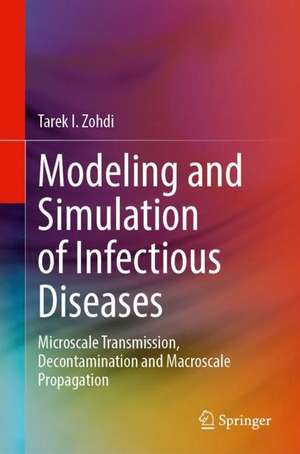Modeling and Simulation of Infectious Diseases: Microscale Transmission, Decontamination and Macroscale Propagation
Autor Tarek I. Zohdien Limba Engleză Hardback – 10 feb 2023
Part 1: Macroscale disease propagation,
Part 2: Microscale disease transmission and ventilation system design,
Part 3: Ultraviolet viral decontamination, and
Part 4: Vaccine design and immune response.
It is important to emphasize that the rapidspeed at which the simulations operate makes the presented computational tools easily deployable as digital twins, i.e., digital replicas of complex systems that can be inexpensively and safely optimized in a virtual setting and then used in the physical world afterward, thus reducing the costs of experiments and also accelerating development of new technologies.
| Toate formatele și edițiile | Preț | Express |
|---|---|---|
| Paperback (1) | 1015.39 lei 6-8 săpt. | |
| Springer International Publishing – 10 feb 2024 | 1015.39 lei 6-8 săpt. | |
| Hardback (1) | 1021.72 lei 6-8 săpt. | |
| Springer International Publishing – 10 feb 2023 | 1021.72 lei 6-8 săpt. |
Preț: 1021.72 lei
Preț vechi: 1075.49 lei
-5% Nou
Puncte Express: 1533
Preț estimativ în valută:
195.68€ • 201.60$ • 163.92£
195.68€ • 201.60$ • 163.92£
Carte tipărită la comandă
Livrare economică 22 februarie-08 martie
Preluare comenzi: 021 569.72.76
Specificații
ISBN-13: 9783031180521
ISBN-10: 3031180526
Pagini: 111
Ilustrații: XX, 111 p. 35 illus., 21 illus. in color.
Dimensiuni: 155 x 235 mm
Greutate: 0.37 kg
Ediția:1st ed. 2022
Editura: Springer International Publishing
Colecția Springer
Locul publicării:Cham, Switzerland
ISBN-10: 3031180526
Pagini: 111
Ilustrații: XX, 111 p. 35 illus., 21 illus. in color.
Dimensiuni: 155 x 235 mm
Greutate: 0.37 kg
Ediția:1st ed. 2022
Editura: Springer International Publishing
Colecția Springer
Locul publicării:Cham, Switzerland
Cuprins
Preliminaries: Basic Mathematics, Optimization and Machine-Learning.- Macroscale Disease Propagation.- Microscale Disease Transmission and Ventilation System Design.- Ultraviolet Viral Decontamination.- Vaccine Design and Immune-System Response.- Epilogue.
Recenzii
“This book presents good and timely work that offers comprehensive insights into the mathematical modeling of infectious diseases. Its blend of theory and practical application makes it a valuable resource for people in public health, epidemiology, computational modeling and mathematical biology. It not only addresses a challenging public health issue but also sets a precedent for how complex health systems can be tackled through innovative computational approaches.” (Chengjun Sun, zbMATH 1528.92001, 2024)
Textul de pe ultima copertă
The COVID-19 pandemic that started in 2019-2020 has led to a gigantic increase in modeling and simulation of infectious diseases. There are numerous topics associated with this epoch-changing event, such as (a) disease propagation, (b) transmission, (c) decontamination, and (d) vaccines. This is an evolving field. The targeted objective of this book is to expose researchers to key topics in this area, in a very concise manner. The topics selected for discussion have evolved with the progression of the pandemic. Beyond the introductory chapter on basic mathematics, optimization, and machine learning, the book covers four themes in modeling and simulation infectious diseases, specifically:
Part 1: Macroscale disease propagation,
Part 2: Microscale disease transmission and ventilation system design,
Part 3: Ultraviolet viral decontamination, and
Part 4: Vaccine design and immune response.
It is important to emphasize that the rapid speed at whichthe simulations operate makes the presented computational tools easily deployable as digital twins, i.e., digital replicas of complex systems that can be inexpensively and safely optimized in a virtual setting and then used in the physical world afterward, thus reducing the costs of experiments and also accelerating development of new technologies.
Part 1: Macroscale disease propagation,
Part 2: Microscale disease transmission and ventilation system design,
Part 3: Ultraviolet viral decontamination, and
Part 4: Vaccine design and immune response.
It is important to emphasize that the rapid speed at whichthe simulations operate makes the presented computational tools easily deployable as digital twins, i.e., digital replicas of complex systems that can be inexpensively and safely optimized in a virtual setting and then used in the physical world afterward, thus reducing the costs of experiments and also accelerating development of new technologies.
Caracteristici
Emphasizes elementary modeling, numerical methods, and their implementation on physical problems Is motivated by real-world phenomena involving various aspects of infection diseases Written by an expert in the field
